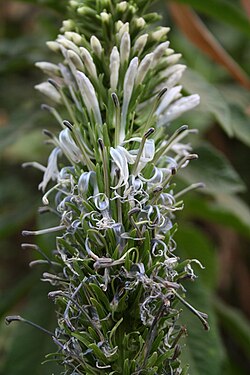| Lobelia columnaris | |
|---|---|
 | |
| Inflorescence of Lobelia columnaris, Laikom (Cameroon) | |
| Scientific classification | |
| Kingdom: | Plantae |
| Clade: | Tracheophytes |
| Clade: | Angiosperms |
| Clade: | Eudicots |
| Clade: | Asterids |
| Order: | Asterales |
| Family: | Campanulaceae |
| Genus: | Lobelia |
| Species: | L. columnaris |
| Binomial name | |
| Lobelia columnaris | |

Lobelia columnaris is a species of plant in the family Campanulaceae. It is the only giant Lobelia occurring in West Africa and is found in Cameroon and Equatorial Guinea. Its natural habitat is subtropical or tropical dry forests.
